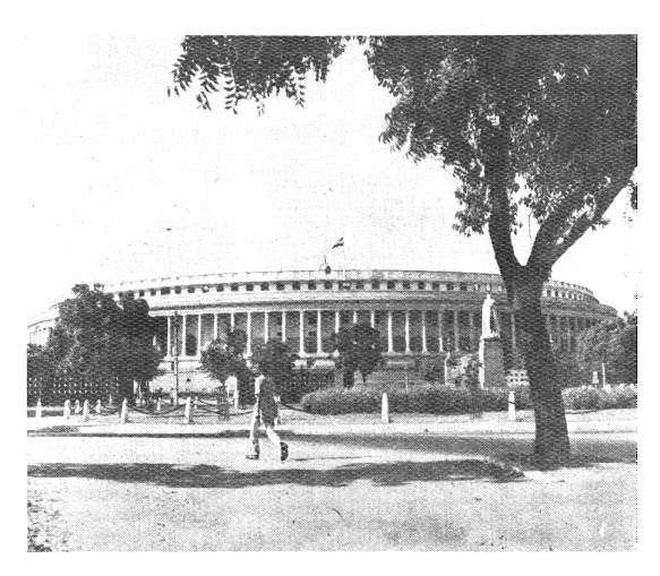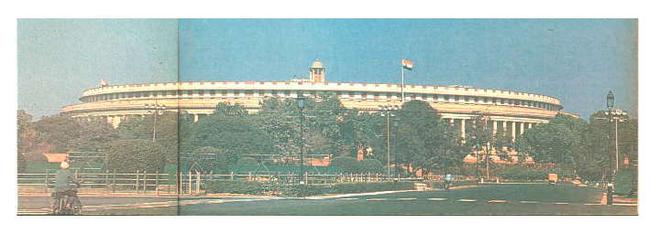Triangular Vs Circle: The architect Sir Herbert Baker hated the final design based on which the old Parliament was constructed. Baker’s first plan was an equilateral triangle, the three sides or wings being approximately 1,000 feet each, to house the chambers- the Legislative Assembly, the Council of State and the Chamber of Princes- linked to a central imposing dome that would filter the light. This way instead of the circular building with its colonnaded corridors we would have seen a dome, perhaps bigger than the one at Rashtrapati Bhawan. But by 1920s after 9-years of working together, Baker and the principal architect of New Delhi Edwin Landseer Lutyens, no longer could see eye-to-eye. Lutyens was bitter, because the two secretariats (North & South block) blocked out the view of Viceroy’s House or Rashtrapati Bhawan and were waiting for an opportunity to hit back. He fought Baker’s design claiming that it jarred with the rest of the city’s design instead arguing for a “circular, colosseum design”. On the 10th January 1920, the New Capital Committee decided in favour of Lutyen’s plea who said in reply to the decision, “I have got the building where I want it and the shape I want it.’ Though Baker redrew the plan, with the three chambers placed at equal angles around a low-domed circular hall but he dubbed it as a “merrie-go-round. He felt the wrap-around, colonnaded corridor was a waste of space and money. The design was also ridiculed in the British press.

How the Parliament Came To Have Its Own Security Personnel: The British Government brought in Public Safety Bill 1929 aimed at curbing the communist movement in India. It gave sweeping powers to the government including detaining individuals considered as threat to public safety, without trial for up to two years. President of Legislative Assembly Vithalbhai Patel said that any discussion on the bill in the assembly could prejudice the Meerut trial where 31 alleged communists including three Englishmen were under trial for orchestrating a railway strike. The British Government challenged his stand and a prolonged debate ensued on whether Patel as the chair of the legislative assembly had the power to stall the bill. On 8th April 1929, just as he rose to give his final ruling on the subject, two bombs were dropped from the visitor’s gallery. They burst among the official benches injuring a few members. No one died. After the bombs, came a volley of red leaflets wherein was inscribed the message which meant that ‘only the sound of an explosion could be expected to reach the deaf.” The bombers were Bhagat Singh and Bakuteshwar Dutt. The bombing for the first time brought the security of the assembly premises to the fore. The question was who is responsible for it? The Government of India and the Chief Commissioner of Delhi maintained that they were the sole judges of the adequacy of the protective measures in the House. Patel, on the other hand, asserted that the authority and control over the precincts of the Assembly should vest in the Chair and ordered on 20th January, 1930 that the galleries (press, visitors and so on) be closed till such time as a settlement in the matter was arrived at. After negotiations, an agreement was reached a month later which laid the foundation of the present watch and ward staff for Parliament House. The present position is that all security arrangements in the precincts of the House are under the control of the Speaker who exercises his authority through the officers directly appointed by him.

Was Baker’s Building big enough to accommodate the Indian Parliament? The simple answer would no. The chamber where the central legislative assembly sat and which was converted as Lok Sabha, was originally designed with a floor area of 3688 square feet and seating arrangement for 148 members. After the first general election in 1951-52 the chamber was remodelled and the floor area was increased to 4804 square feet to provide accommodation to 450 members. The wall of the chamber was knocked off, to include a portion of the outside lobby in the chamber. The original wall was replaced with twelve marble columns. As the strength of the Lok Sabha grew so did the requirement for space forcing some MPs to sit behind the pillars.
Parliament Building was the first home of the Indian Supreme Court: The Chamber of Princes which was constructed by Baker for the assembly of rulers of Indian states was in pre-Independence India also made available to the Federal Court of India for use as a court room when the chamber of princes was in session. After independence the chamber was regularly used by the Supreme Court for over ten years, till in 1958 it finally shifted to its own building. The chamber was then redesigned as the Library Hall. It still bears 102 emblems of the erstwhile Indian States.
The Honourable MP: The first sitting of elected Lok Sabha and Rajya Sabha was on 13th May 1952. The Parliament was still fine-tuning many of the operational details. One such detail, that probably the Constitution makers and our early Parliamentarians forgot to look was who exactly is entitled to the appellation “honourable”. On 20 December 1952 just as Lok Sabha sat for the day, the marshal announcing the Speaker’s entry to the house shouted, “Sabhasado-Mananeeya Adhkyash ji” (Members the honourable Speaker). Now, one the MP took it as an affront and protested. Counting his objection as valid, the Speaker immediately ruled that every member regardless of their party or Parliamentary position has to be called “honourable.”







